Mercedes blends sports sedan, SUV in GLC43 Coupe
Filed under: Weekly test drives, Autos
By John Gilbert
Mercedes Benz has maintained a consistent trajectory onward and upward with both its sedans and SUVs, and as a virtual poster-child for the blending of cars and SUVs, the 2020 Mercedes AMG GLC43 Coupe is either a very sporty compact SUV, or a slightly taller high-performance sedan that will go off-road.
GLC is the standard designation for the company’s compact sports-utility vehicle, and it won Motor Trend’s SUV of the year award when it was born for 2019. Ah, but now it fits the appearance of a compact SUV that wants to fill a sedan’s shoes, it gets both the 4-door “Coupe” treatment, and the high-performance makeover by AMG engineers.
That all conspires to make the AMG GLC43 Coupe the ultimate tool of subterfuge to confuse the vehicle-buying public. AMG used to take the sportiest Mercedes sedans and give them a sporty upgrade in power and performance, expanding to include suspension, interior, seats, and even the steering wheel, and then it gained some identifying bits of added-on grooves, contours and special effects. AMG became so prominent that Mercedes took on its affiliate to make it part of the company.
Walking up to the GLC43, I was taken by the brilliant blue metallic paint — identified as “Brilliant Blue Metallic,” in a simple, straightforward description. It is not as dark as deep navy and not as bright as royal. As a compromise, it is a unique color, even to a blue-freak like me, and I believe I like it better than either navy or royal for a car’s exterior.
If you approach from the rear, you’re thinking you suspected it was an SUV, but you must be mistaken, because that sloped rear roofline has a sporty-car flair, and there are those four silver exhaust tips, and the rear decklid spoiler. From the front, the thin grille conveys more sportiness, so by the time you get ready to climb aboard, you’ve forgotten all the SUV-like traits, and once you get a look at the quilted white leather bucket seats and the high-tech, flat-bottomed steering wheel, you’re ready to drive a sporty sedan. Swiftly.
Under the hood there is a 3.0-liter V6 Biturbo engine, which means a pair of turbochargers feeding the two banks of the V6. It develops 385 horsepower and 384 foot-pounds of torque, which is not only a perfectly balanced distribution but is another example of what AMG can do with a perfectly good 3.0 V6.
You start up the engine, and it sounds calm enough, then you engage the gear lever — which I find odd, no matter how well it works. It is a thin little stalk sticking off to the right of the steering column, right about where most other companies would mount a windshield wiper stalk, while putting the shifter on the console, either as a lever or a rotating knob, or whatever. This little stalk can do three things: up for reverse, down for drive, or in the middle for neutral.
My trouble is that when cruising along, if you happen to hit a tiny bit a misty shower, you might flick the lever up or down, to get just one swipe of the wipers. Except in the Mercedes scheme, you have just shifted the gear selector as if trying to engage reverse — a no-no, for sure — or reinforced your desire to be in drive. My point is that when you intuitively go for the wipers, you are moving the gear shifter. Read more
‘Hot’ CT5-V gets sibling rival in CT5 Luxury
Filed under: Weekly test drives, Autos
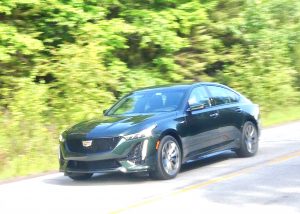
The only green prettier than Duluth foliage might be the Evergreen Metallic of the 2020 Cadillac CT5-V Series.
By John Gilbert
Another quiz on new car identification? Park a 2020 Cadillac CT5 sedan between a CT4 and a CT6, with all of them pointing right toward you. Try to tell them apart, from the vertical rows of running lights on both front fenders to outline their “signature” grilles.
If the CT5 was the V-Series, painted Evergreen Metallic, as was my test car, that would be my pick, because I think it’s the most beautiful green I’ve ever seen on a car.
The near-identical looks are even more similar within the CT5 line itself, with the V-Series aimed at high-performance, and the regular CT5 targeting luxury. It all makes me wonder what I’d have done as a little kid, when my passion for cars far outstripped their aesthetic appeal and technical capabilities. In the 1950s, I would walk out to the top of the big hill we lived on, and watch for any approaching cars on our then-gravel road, and fix my gaze down a couple miles toward Lake Superior’s North Shore Drive. My plan was to see how close an approaching car would have to get before I could identify it. I could discern a 1952 Ford from a 1951 DeSoto, or a 1953 Chevrolet, from a 1950 Cadillac. There weren’t many different models back then, and the proliferation of models would make that a lot more challenging in later years.
The Plymouths and DeSotos of my childhood, as well as Oldsmobile, Pontiac, and American Motors, have all disappeared, among others, and now we’re evolving to fewer and fewer sedans and more and more trucks. But back then, I could discern a 1952 Ford as opposed to a 1951 DeSoto, or a 1953 Chevrolet, or a 1950 Cadillac. There weren’t many different models back in the 1950s, and the proliferation of models would make that a lot more challenging in later years.
Cadillac, however, is still the pinnacle of General Motors, although its models have been reduced to those three remaining sedans. Forget Fleetwood, or de Ville — we’re into CT4, CT5, and CT6. Before they are further reduced, let’s check out the CT5.
I had occasion to get a pair of CT5 sedans back-to-back recently, with the first being a CT5 V-Series. Under the heading of “you can’t tell the players without a program,” my biggest question is why, with only three sedans left, would Cadillac want to make all three look practically identical? Furthermore, it’s interesting that there also is a distinction between the luxury CT5 and the high-performance CT5 V-Series high performer.
That V-Series designation means it was the hot-rod version of the CT5, with a 3.0-liter V6, twin turbocharged to deliver 360 horsepower and 405 foot-pounds of torque, through all-wheel drive. The horsepower peak is at 5,400 RPMs and the torque peaks at 2,350.
The CT5 V-Series was a treat to drive, with dark grey leather bucket seats, and refined comfort throughout. The most pleasant surprise is the V-Series suspension, which is listed as a “luxury compact” in size. It is plenty roomy, which no makes me wonder whether Cadillac is going to stretch the CT5 into the full-size region, or if the compact segment has grown to such dimensions.
The CT5 V-Series accelerates well, with a proper sporty car sound, and you can shift the 10-speed automatic with steering wheel paddles if you want to exploit its sportiest tendencies. The look, with quad tailpipes, and low-profile “summer only” run-flat tires on 19-inch ‘premium painted alloy wheels with pearl nickel finish,” if you’re interested in wheels to that extent. Run-flats work well if you suffer a blowout from a road irregularity and would rather drive on home than have to change a tire. But they are enormously expensive to replace, and they don’t just keep running indefinitely.
Rear seat room is good, even if you have to duck your head a bit to avoid the sloping roof, and the trunk is spacious. Overall, the CT5 V-Series lives up to its billing and is a very satisfying drive. Fuel economy is estimated at 17 city and 25 highway, with a 20 miles per gallon combined figure by the EPA, and if you switch it away from sport you still may have trouble getting more than 20 with all that tempting power.
With magnetic shocks that GM has tried on various Corvettes in the last decade, the V-Series handles very well, and with the blacked-out trim all around, it sets itself apart as a high-performer. Never mind all the creature comforts, with the rear camera, park assist, cross-traffic alert, forward collision alert, lane change alert with blind-spot, nd front pedestrian braking, and the driver awareness package that includes one keep assist with departure warning, head-up display, and “intellibeam” headlights.
Then we get back to the appeal of such a stunning dark green. My wife, Joan, thought it was black for the first night and day she observed me zipping in and out of the driveway. Then she, too, admired the green. We never had occasion to tax the all-wheel-drive system, but it added to the feeling of stability wherever we drove. Base price of the CT5 V-Series is $47,695, and the various upgrades lift it to $58,305. Read more
In fierce SUV competition, Ford has an Edge
Filed under: Weekly test drives, Autos
By John Gilbert
When it comes to building a new truck of any size, Ford has an unfair advantage, it seems. So when the niche-seeking 2020 Ford Edge shows up, we take notice. And there is nothing disappointing about the Edge, especially when it wears the “ST” badge, indicating sporty upgrades in performance and handling.
The Edge might be the right-sized SUV for many consumers who are willing to swap overpowering towing and hauling capacity for agility and fuel-efficiency for everyday family flexibility, without ever risking losing that off-roads advantage. For openers, look at its heritage.
Ford has given us the F-150 pickup truck, which has led the market in sales every year for nearly four decades, and that truck is all-new for 2021, while leaving the company the basic template for forging ahead. The Explorer showed up and captured the imagination of consumers who wanted truck-like durability and the newly created SUV flexibility for family hauling and became the breakthrough vehicle to start and popularize the whole SUV segment.
Ford went both ways at once from there, to build the enormous Expedition and then the even larger Excursion, while also undercutting the Explorer with the compact Escape, which came in as Ford’s smallest sized SUV and immediately became a leader among compact SUVs.
The flow of new vehicles has never abated, and the Edge fit perfectly between the Escape and Explorer, and was joined by interesting specialty SUVs like the Flex, and the subcompact EcoSport, seem to fill every possible niches in the range of segments. It would be easy to get bored with the constant increase in the sheer number of vehicles, except that every time you get a chance to climb aboard any of them, you come away impressed.

With my wife, Joan, and older son Jack, we filled the Edge ST with hiking/walking stuff and parked on Duluth’s Skyline Drive.
The 2020 Edge is built on a platform that was new for 2019 and is firm and refined and stiff enough to provide excellent handling around corners without ever tending to be harsh. For my road-test week, I cheated just a little, without even trying. The bright “Race Red” Edge that came to my driveway just up the North Shore from Duluth, Minnesota, was the ST version, which was introduced about a year ago and means this Edge had a distinct edge in sporty performance as well as appearance.
The basic Edge starts with Ford’s peppy 2.0-liter EcoBoost 4-cylinder engine and it is more than adequate for performance of the well-sized Edge. But the ST version takes a major leap forward, with the 2.7-liter EcoBoost V6 that develops 335 horsepower at 5,550 RPMs, and 380 foot-pounds of torque at 3,250 RPMs. That’s 90 horsepower and 105 foot-pounds more than the EcoBoost 4.
Light to medium trailer towing for camping or a fishing boat is no problem, and the 8-speed automatic transmission seamlessly finds the right gear regardless of load. If it doesn’t, in your estimation, you can simply click the shift paddles to up or down shift.
That makes the Edge ST about the most potent way to haul around a family of five as you can imagine, and once you climb into that attractively stitched leather bucket driver’s seat, your first objective is to start up from a stop without giving a dose of whiplash to the four other occupants. The Edge ST is sort of a race-car in compact SUV form, and while the base engine is adequate, the 2.7 twin-turbo is a rocket.
The color is up to the task of announcing your arrival, and the 21-inch black alloy wheels and performance tires set off the styling further. The blacked-in grille and the front styling with its faired-in headlights and foglights also are projected, to coin a phrase, at both usefulness and style. Read more
Symbol of luxury, Avalon gets TRD spark
Filed under: Weekly test drives, Autos
By John Gilbert
We can appreciate Toyota’s efforts to lift up some previously-boring sedans and give them a dose of performance, such as the Camry, Corolla, and even a couple of Lexus sedans, and we can celebrate the company’s producing some advanced platforms and even new engines as well as major alterations in its hybrid systems.
Throughout the corporate wide renovations, though, we could all take comfort in knowing there will always be an Avalon.
The Avalon has always been an interesting sedan, a stretched version of the popular Camry midsize car, but always loaded up with luxury features. In its lifetime, I always had the theory that since Toyota spun off Lexus as a separate brand for luxury versions of various Toyotas, the company’s preferred progression for customers was to start off with a Corolla, and after a couple of them, move up to a midsize Camry, and after a couple of them, move on into the Lexus brand for something a little more expressive.
Along the way, however, some Toyota customers who loved their mainstream Camrys, decided it might be a bit pretentious to have the neighbors drive by and see a Lexus in their driveway. For those folks, the Avalon was the perfect vehicle. Longer and roomier than the Camry, and with a lot of Lexus-like creature features, the Avalon was there for them, at the top of the Toyota car list.
So we can excuse Toyota for allowing the Avalon to remain constant, naturally tweaking it here and there with interior plushness and upgrading the exterior design now and then. But new chairman Akio Toyoda needn’t include the Avalon in the performance swath covering some of the other models.
And then a new 2020 Avalon was delivered to my house in Duluth, Minnesota, and to my surprise, bordering on shock, I found the stunning red — Supersonic Red, thank you — Avalon had the letters “TRD” emblazoned on the rear deck. TRD stands for Toyota Racing Division, and it gained its popularity for creating some pretty incredible off-road versions of Toyota’s Tundra and Tacoma pickup trucks. When Toyota moved into NASCAR racing with some totally illogical Camry models — front-engine V8s with rear-wheel drive, neither of which exist in the Toyota line — TRD expanded its reach. Read more
Alfa gives Stelvio a little dose of Formula 1 spirit
Filed under: Weekly test drives, Autos
By John Gilbert
If you owned an Alfa Romeo Stelvio, there would be several ways to point out that you are supremely lucky.
That’s the first indication, because you’re lucky enough to be driving this specialty SUV, which is one of the best-driving and most satisfying vehicles — cars, sports cars, trucks or SUVs — in the world.
Another good luck symbol is the neat little 4-leaf clover emblazoned on the flanks. That stands for Quadrifoglio, which means it is the hot one of the bunch, with all-wheel drive and perhaps the most sophisticated engine put under the hood of any production vehicle.
A third indication of your good fortune is that you might have accumulated a good fortune, in business or whatever your job might be, because you’ve made enough money to be able to afford the sticker price on the Alfa Romeo Stelvio — a cool $96,540 for my week-long test-drive Stelvio.
No, you don’t have to spend that much on the high-end Stelvio. which comes for far less with the base engine, but if you’ve got it, what could be more fun than to spend a chunk of it to get such a vehicle equipped with the 2.9-liter V6 designed and hand-built by Ferrari’s Formula 1 engineers? Think about all the overpowered sporty cars and trucks that have engines up and over 6 liters in displacement just to get enough power to satisfy their buyers. Yet, with the right technology, and engineering brilliance, the comparatively tiny 2.9 liters of displacement can be designed and perfected to produce 505 horsepower and 443 foot-pounds of torque.
Your neighborhood hot-rodder might be able to tweak any engine into providing extra power, but this is a whole ‘nother plateau. With all the trick parts at their disposal, the same engineering staff that puts the engines in the Formula 1 race cars driven by Sebastian Vettel and Charles Leclerc on satellite TV most early Sunday mornings was given a challenge by the late and charismatic leader, Sergio Marchione. As the head man at Fiat, and thus Fiat Chrysler Automobiles, Marchione had orchestrated the design and building of the Alfa Romeo Giulia, a beautiful car with near-perfect handling. Because Fiat not only owns Chrysler, Jeep, Alfa Romeo, and Ferrari, he went directly to Ferrari’s Formula 1 engineers and told them he needed an engine that would be as special as the Giulia’s design, because that would be the car that would help ease Alfa Romeo back into the U.S. market.
Once built, Alfa also offers the car with an outstanding 2.0-liter 4-cylinder, designed by Chrysler engineers, and allowing the Giulia outstanding performance for about $30,000 less. That’s the way I would buy the car, because it is quick, has the same superb handling, and meets the requirements of Marchione’s demands. But once you drive the Giulia with the hot engine, you will be spoiled. This Sunday, the Formula 1 tour goes to Spain, and while Vettel is having a tough year, and Leclerc is proving to be a young star in the making, we can only marvel at the incredible power that makes F1 cars the swiftest and most exciting form of motorsports on the planet.
And while there is always something about driving an Alfa that causes a smile to cross your face, the company proved that it is not an insult to humanity to try to do the same thing with an SUV. The Stelvio appeared as if by magic, like a tall and roomy Giulia wagon, and with the 2.0 twin-turbocharged V6, it flies around corners and teaches you to always pay attention to your gauges. That’s even more of a requirement if you have the 2.0 V6. At least a dozen times I found myself glancing down and saying, “Oops, I can’t be going that fast here ion town.” The car requires close monitoring, because that engine wants to go.
The fact that the Stelvio is an SUV, with more clearance, and the seemingly incongruous ability to do a little light off-roading, you have these mode controls that you can switch from normal driving to sport, track, and track-plus, and you can click a different button and the low murmur of that engine suddenly becomes not-low anymore, but roaring with the urgency and intensity of a race-car engine. It is not sound, so much as refined mechanical music. Read more


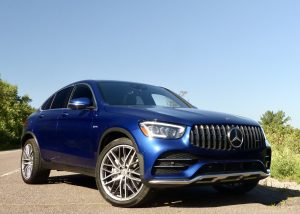
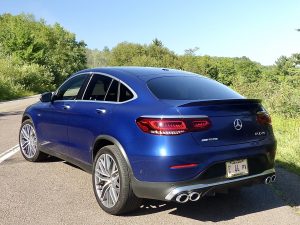
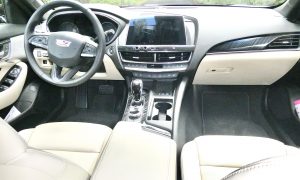
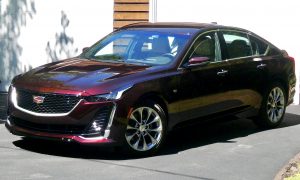

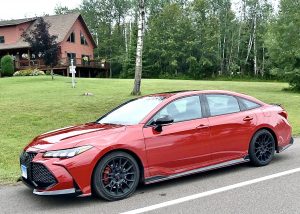



 John Gilbert is a lifetime Minnesotan and career journalist, specializing in cars and sports during and since spending 30 years at the Minneapolis Tribune, now the Star Tribune. More recently, he has continued translating the high-tech world of autos and sharing his passionate insights as a freelance writer/photographer/broadcaster. A member of the prestigious North American Car and Truck of the Year jury since 1993. John can be heard Monday-Friday from 9-11am on 610 KDAL(www.kdal610.com) on the "John Gilbert Show," and writes a column in the Duluth Reader.
John Gilbert is a lifetime Minnesotan and career journalist, specializing in cars and sports during and since spending 30 years at the Minneapolis Tribune, now the Star Tribune. More recently, he has continued translating the high-tech world of autos and sharing his passionate insights as a freelance writer/photographer/broadcaster. A member of the prestigious North American Car and Truck of the Year jury since 1993. John can be heard Monday-Friday from 9-11am on 610 KDAL(www.kdal610.com) on the "John Gilbert Show," and writes a column in the Duluth Reader.